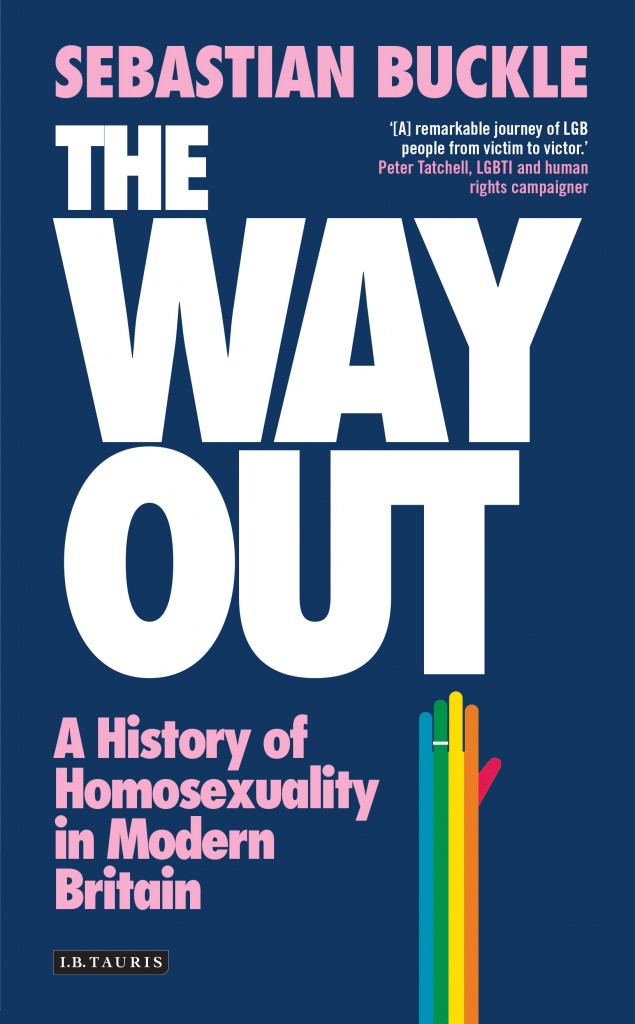Interview by Justin Bengry
In just 37 years, homosexuality in Britain moved ‘from criminality and discrimination to the centre of mainstream life’. Sebastian Buckle’s book The Way Out: A History of Homosexuality in Modern Britain traces changes in the representation and policing of homosexuality, as well as homosexual identities across this remarkable period. At the beginning of 1967, all sex between men remained criminalised. But decriminalisation, which occurred late that year, was partial: it only applied to England and Wales, it excluded the armed forces, and it set the age of consent for homosexual men at 21. By 2004, the age of consent was equalised and references to ‘gross indecency’ and buggery were struck from legal statutes. The following year, the state recognised same-sex civil partnerships. How, asks Buckle, did this incredible change occur? What influences in British society prompted such transformation? And how can this be traced through media and discourse?

Justin Bengry: How would you broadly characterise the major changes in queer identities in Britain in the twentieth-century?
Sebastian Buckle: One of the main premises of my book is that public and personal identity is in an almost constant flux. The way queer men and women identified themselves and were identified by others changed almost beyond recognition throughout the twentieth century. Thus my research has been about exploring the development of a public discourse on homosexuality through the images, ideas, and judgements made about queer lives.
For me, the main change in queer identity has been around public visibility – through a willingness of the media, politicians, the law, and others to engage in an open conversation about homosexuality. The result has been a broad progression in the ability of men and women to live openly queer lives, and move away from rigid definitions of sexuality, although this has of course taken place at different speeds and with its own set of challenges.
The twentieth century has seen remarkable changes in definitions of sexual identity and there is now an increasing sense of living in a multiple-identity world, where sexuality sits alongside other labels of personal and public identity as equal definitions of the self.
JB: To what extent would you say that Jeffrey Weeks’s involvement in the Gay Liberation Front inflected his scholarship? In other words, how useful is Weeks’s own work as a primary source?
SB: I think Weeks has been fundamental in advancing our understanding of the nature of sexual identity, although as I argue in my book, I think his work has focused on self-created labels and identities whereas my focus has been on those identities imposed or influenced by other sources. Working during the gay liberation period, it is understandable that he chose to focus on this important aspect of identity, and there is a definite trajectory in his writing which lends itself to historical analysis in its own right. I think it is a really interesting idea to study his work as an historical source, as it is clear that he influenced the debate about identity while at the same time recording it. Indeed, part of my research looks at the social lives of queer people throughout the second half of the twentieth century and how their attempts at formulating their own sense of self impacted on the broader discourse taking place beyond these small groups.
JB: You note that the model of discretion and respectability that underpinned the politics of the Homosexual Law Reform Society in the 1950s and 1960s was ‘not an identity that the majority of homosexual men could identify with’. How would you characterise homosexual men at this time?
SB: The HLRS was made up almost entirely by heterosexual social reformers who, with mostly good (albeit misguided) intentions, aimed to project a specific image of respectability and discretion onto the early concept of the homosexual. They did this because they entertained a mixture of sympathy at the position of the homosexual man, while also subscribing to negative ideas around inculcation and abuse. Meanwhile, men who engaged in same-sex activity were rarely labelling their desires or formulating them into an identity politics. They were struggling with their feelings, or else seeking out opportunities for sex in a world which would not have defined their identity by their sexuality. Thus, the ‘homosexual man’ was never a fully realised concept that extended much beyond small groups of men who were willing to identify themselves as homosexual, and belonged to a class which enabled them to project this image. Some of the characters that appeared in This Week: Homosexuals on ITV in 1964 and Man Alive, Consenting Adults: The Men on BBC in 1967 spring to mind.
JB: The lesbian magazine Arena Three (1964-1972) ran through the end of the homophile era and into the period of gay liberation. How was this publication inflected by the changing queer politics of Britain?
SB: Arena Three, and the Minorities Research Group (MRG) that produced it, was – like the HLRS – a middle-class organisation which had very specific ideas about what it meant to be a lesbian. The appearance of MRG-founders Cynthia Reid and Julie Switsur during the BBC’s Man Alive, Consenting Adults: The Women documentary is particularly telling, with Reid commenting: ‘I think many lesbians could help themselves by ceasing to be obsessed with their own lesbianism – that is, regarding it as simply a part of their personality and not the whole of it.’
Unlike the HLRS, the magazine and the organisation were made up of lesbians and not heterosexual reformers. There was thus space (albeit within readers’ letters) for an ongoing debate about identity and what it meant to define oneself as a lesbian. Taking its cue from the homophile movement, this tended to concentrate on the romantic side of female same-sex relationships, and on presenting female homosexuality as inherently normal.
The magazine disliked butch women, and while readers did write in to talk about gay liberation and implore women to join, the influence of Esme Langley (another MRG founder who maintained strict editorial control of the magazine) meant that it avoided references to sex and sexual liberation which were so key to the gay liberation movement. This helps explain the reasons for why the magazine folded when it did, replaced by the more diverse Sappho.
JB: Your study relies extensively on media sources. To what extent did you find queer identities and communities to be mediated through media and popular culture?
SB: My research has been entirely about the discourse created around homosexuality, which has inevitably played itself out through the media and popular culture. I came to the topic with a specific desire to understand how the majority of people understood sexuality when they were not part of groups which came into contact with queer people.
While the discourse may not have accurately reflected queer lives (seen in particular through the furore around the promotion of homosexuality in the 1980s), it nevertheless represented a reality for the majority when labelling gay people. This was particularly the case since the period witnessed the exponential growth of media and popular cultural representations of homosexuality, as well as the growth of media in general. These ideas around homosexuality – however inaccurate – were in turn used to influence individual behaviours as queer people tried to make sense of their own sexuality.
My book ends on an optimistic note – pointing out that by highlighting the historical construction of these ideas in building identities, we can begin to think about how we really want to be defined, and how we want to define others.
JB: How does your story contribute to recent studies in queer history that challenge the stability of sexual identities before the 1960s?
SB: My work sits alongside these histories as part of a broader historiography which shows how the labels with which we have become accustomed to describing sexual identities simply did not exist before the 1960s.
Works like Matt Houlbrook’s Queer London have been instrumental in highlighting the sheer variety of experiences in a world which did not define people based on their sexuality; my work reinforces that by exploring the origins of the sexual labels which those works seek to challenge.
The combined historiography paints a fascinating picture of the constantly evolving way society understands and defines human sexuality, which works to challenge prejudice and encourage more open thinking on the limitations we set for ourselves when trying to compartmentalise sex and sexuality.
JB: Whose stories were left out of your book and why? What would you include had you been able to?
SB: The book tells the history of homosexuality in Britain, while at the same time exploring the evolution of a discourse on sexuality, which helped shape sexual identity. It concentrates on examples of arenas in which homosexuality had been discussed, while maintaining a chronological narrative necessary to maintain fluency for the reader. But this inevitably meant that there were limits to the stories which could be told.
I used Britain as a case study, and focused on British-created ideas about identity – in the law, politics, the media, and the social lives of queer people (albeit influenced by American culture). I left out specific American influences in TV, film, magazines, and culture. I did the same with European organisations, not because the UK existed in a bubble without those outside influences, but because I wanted to look at specifically British created ideas, and the influence of external sources would have doubled the size of the book.
Similarly, I had to leave out explorations of novels, music, pornography, plays, and poetry from within the UK, with the sources I included only serving as examples which influenced the discourse at the centre of my work. I have recently finished a second book, this time on British television (Homosexuality on the Small Screen), which has given me the opportunity to look at the topic in greater depth than was possible in The Way Out.
JB: How do you see your book being most effectively used in the classroom? What would you assign it with?
SB: My book works both as a history of homosexuality in the second half of the twentieth century and as a study of the role of a discourse on homosexuality which shaped sexual identity.
The ideas and examples – in particular where it is possible to see direct influences from newspaper hysteria to political debate (with, in some cases, MPs directly quoting from newspapers in the House of Commons) – serve to challenge the reader to see for themselves the construction of identities in modern society. While the book is about homosexuality, the concept is equally true of gender, ethnicity, nationality, class, and age, amongst others. Thus, as well as sitting alongside work by Jeffrey Weeks, George Chauncey, Matt Houlbrook, and Rebecca Jennings, it also works well with other books from history, cultural studies, sociology, and gay and lesbian studies.
 Sebastian Buckle is a historian of homosexuality and sexual identity. His first book The Way Out: A History of Homosexuality in Modern Britain was published with I.B Tauris in 2015 and he has just submitted his second book Homosexuality on the Small Screen: Television and Gay Identity in Britain for publication next year. He was awarded his PhD in 2013 from the University of Southampton, entitled ‘Homosexual Identity in England, 1967-2004: Political Reform, Media and Social Change’. Sebastian tweets from @sebbuckle
Sebastian Buckle is a historian of homosexuality and sexual identity. His first book The Way Out: A History of Homosexuality in Modern Britain was published with I.B Tauris in 2015 and he has just submitted his second book Homosexuality on the Small Screen: Television and Gay Identity in Britain for publication next year. He was awarded his PhD in 2013 from the University of Southampton, entitled ‘Homosexual Identity in England, 1967-2004: Political Reform, Media and Social Change’. Sebastian tweets from @sebbuckle
 Justin Bengry is a Research Fellow on the project Queer Beyond London at Birkbeck, University of London and researcher on the Historic England LGBTQ heritage and mapping project Pride of Place: England’s LGBTQ Heritage. Justin’s research focuses on the intersection of homosexuality and consumer capitalism in twentieth-century Britain, and he is currently revising a book manuscript titled The Pink Pound: Queer Profits in Twentieth-Century Britain, which is under contract with the University of Chicago Press. He tweets from @justinbengry
Justin Bengry is a Research Fellow on the project Queer Beyond London at Birkbeck, University of London and researcher on the Historic England LGBTQ heritage and mapping project Pride of Place: England’s LGBTQ Heritage. Justin’s research focuses on the intersection of homosexuality and consumer capitalism in twentieth-century Britain, and he is currently revising a book manuscript titled The Pink Pound: Queer Profits in Twentieth-Century Britain, which is under contract with the University of Chicago Press. He tweets from @justinbengry

NOTCHES: (re)marks on the history of sexuality is licensed under a Creative Commons Attribution-NonCommercial-NoDerivatives 4.0 International License.
Based on a work at www.notchesblog.com.
For permission to publish any NOTCHES post in whole or in part please contact the editors at NotchesBlog@gmail.com





Esme Langley (1919-1992) was the sole person legally responsible for MRG and Arena 3. She had been advised this was the only way to avoid charges of “conspiracy to corrupt…” when publishing a newsletter on lesbianism.